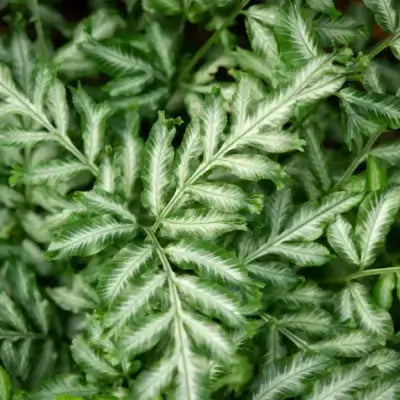Indoor Care for Brake Fern:
-

1. Light: Brake ferns prefer bright, indirect light. Direct sunlight can scorch the fronds, so it's best to place the plant near a window with filtered light or in a well-lit room.
2. Temperature: They thrive in moderate temperatures, ideally between 60-75°F (15-24°C). Avoid placing them in drafty areas or near heating vents.
3. Humidity: Brake ferns require high humidity levels. You can increase humidity by misting the plant regularly, using a humidity tray, or placing a humidifier nearby.
4. Watering: Keep the soil consistently moist but not waterlogged. Water the plant when the top inch of soil feels dry. Be careful not to let the soil dry out completely.
5. Soil: Use a well-draining, peat-based potting mix. Adding some perlite or sand can improve drainage.
6. Fertilization: Feed the fern with a balanced, water-soluble fertilizer every 4-6 weeks during the growing season (spring and summer). Reduce feeding during the dormant period (fall and winter).
7. Pruning: Remove any dead or yellowing fronds to encourage healthy growth and improve the plant's appearance.
8. Repotting: Repot the fern every 1-2 years or when it becomes root-bound. Choose a pot that is one size larger and refresh the soil.
Outdoor Care for Brake Fern:

1. Light: In outdoor settings, brake ferns prefer partial to full shade. They can tolerate some morning sun but should be protected from intense afternoon sun.
2. Temperature: Brake ferns are hardy and can tolerate a range of temperatures, though they generally do best in mild climates. In colder regions, they may die back in winter but will regrow in spring.
3. Watering: Keep the soil evenly moist, especially during dry spells. Mulching around the base can help retain moisture and regulate soil temperature.
4. Soil: Plant brake ferns in well-draining, loamy soil enriched with organic matter. They prefer slightly acidic to neutral soil.
5. Spacing: Give each plant enough space to spread, as they can grow quite large. Space them at least 3-4 feet apart to allow for proper air circulation and growth.
6. Fertilization: Apply a balanced, slow-release fertilizer in early spring to support new growth. Avoid over-fertilizing, as it can lead to excessive foliage and weak growth.
7. Mulching: Use organic mulch, such as bark chips or leaf mold, to help retain moisture and suppress weeds.
8. Pruning: Trim back dead or damaged fronds to maintain a tidy appearance. In colder climates, cut back the fern to the ground in late fall after the first frost.
9. Pest Control: Monitor for common pests such as aphids, slugs, and snails. Use appropriate organic or chemical treatments if necessary.
By following these care guidelines, you can ensure that your brake fern remains healthy and vibrant, whether indoors or outdoors.
A Guide to Adding Brake Fern to Your Garden
The brake fern adds distinctive appeal to garden spaces with its finely split fronds and tender lace-like look. This graceful Pteris or ribbon fern plant stands out for its vibrant green leaves while thriving indoors and outdoors. Brake fern thrives in appropriate conditions to become a lush focal point that adds vitality to dim areas. The preference of ferns for indirect light and abundant moisture makes them attractive for gardeners who desire understated beauty to enhance vibrant flowers or bold foliage.
Please select the location for the brake fern by considering its need for soft light conditions. The fronds stay vibrant when exposed to bright sunlight that's spread out to prevent burning. When placed outdoors, ferns grow best beneath the filtered shade of larger shrubs or trees. Brake fern thrives indoors with mild light from north- or east-facing windows. Brake fern survives in lower light conditions better than sun-loving plants, enabling gardeners to use it effectively in shaded locations. This plant's ability to succeed in diverse conditions makes it popular among beginner and expert gardeners.
The health of brake fern plants heavily depends on appropriate soil preparation. A well-draining yet moisture-retentive potting mix ensures brake fern growth remains steady by replicating its natural environment. Ferns flourish best in organic-rich acidic soil that drains appropriately while preserving their preferred humid environment. Compost or leaf mold added to the soil enhances nutrient levels and ensures loose conditions around plant roots. Brake fern grows well in well-aerated soil conditions, which allow its roots to breathe while its fronds expand, although it can handle heavier soil types.
Once planted, brake fern appreciates consistent hydration. The root system must maintain moderate moisture levels but never become waterlogged. Outdoor ferns benefit from mulch or leaf litter, which locks in moisture and reduces watering frequency. Indoor plants benefit from regular misting when they experience dry air conditions. The brake fern's tropical and subtropical origins mean it thrives and develops healthy growth under high humidity conditions. Maintaining appropriate humidity levels prevents leaf crisping and browning on the tips of the plant.
Fertilization plays a crucial role in developing a vigorous brake fern. Feeding your plant intermittently with an organic balanced fertilizer helps maintain healthy leaves while stimulating new frond formation. A small amount of treatment produces substantial results. Excessive feeding results in burned leaf margins and creates weak plant growth through overstimulation. Regularly feeding the fern with diluted solutions helps preserve its natural growth pattern and aesthetic appeal.
When positioned in an appropriate environment, the brake fern becomes the centerpiece of tranquil beauty. The ferns' delicate fronds produce an elegant yet calming atmosphere ideal for garden nooks or windowsill displays. Correct soil conditions, along with suitable light exposure and moisture levels, will allow you to appreciate the brake fern's delicate textures and graceful silhouettes, which make it an intriguing plant addition.
